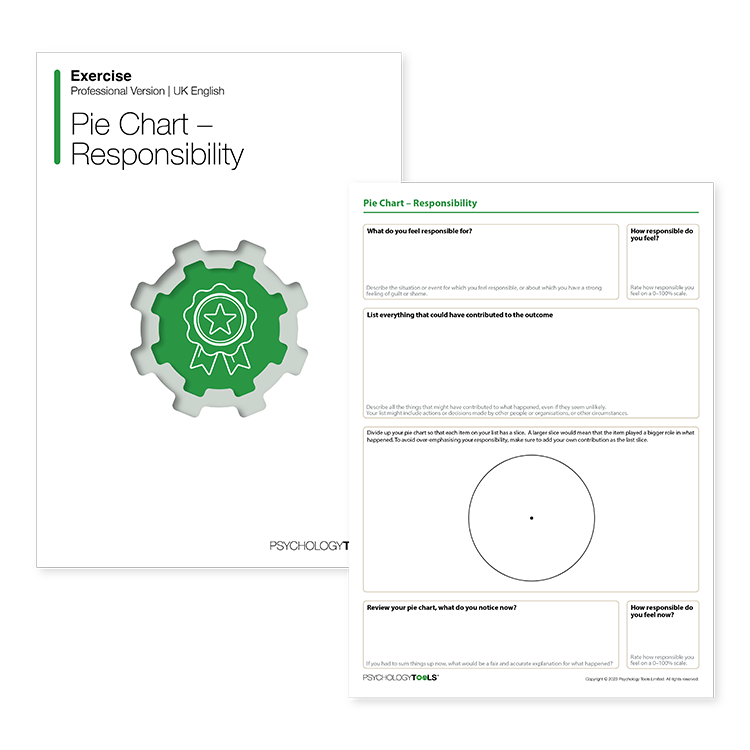Pie Chart - Responsibility
The Pie Chart - Responsibility exercise is designed to guide clients through the process of clarifying and re-evaluating their responsibility for negative events. The aim is not to absolve the client of responsibility or minimize accountability when it is legitimate, but to establish a more reasonable, reality-based perspective (Scurfield, 1994).

Related resources
Tags
Languages this resource is available in
- English (GB)
- English (US)
- Finnish
- Hindi
- Italian
Problems this resource might be used to address
Techniques associated with this resource
Mechanisms associated with this resource
Introduction & Theoretical Background
Feelings of guilt are often associated with the belief that one should have acted, thought, or felt differently. They can be helpful when they motivate pro-social behaviors, such as apologizing or making amends, but sometimes people feel guilt or shame because they are blaming themselves inappropriately or feeling overly responsible for events. This is especially apparent in survivors of trauma.
Feeling guilty is not always an accurate signal of responsibility. Cognitive biases that are known to contribute to excessive guilt and inaccurate attributions for events include:
- Hindsight bias, in which the individual conflates an outcome with what they knew at the time (Fischoff, 1975).
- Black and white thinking, in which the individual does not appreciate the multitude of factors that contributed to an event.
- Personalizing, in which the individual falsely assumes that situations or outcomes are related to themselves (particularly negative ones).
Regarding responsibility, several cognitive processes may account for the excessive and inappropriate guilt
Therapist Guidance
It sounds as though you feel very responsible for what happened. Would you be willing to explore that more with me?
- Identify the situation, event, outcome, or consequence about which the client feels a strong sense of responsibility, or where they feel a strong sense of guilt or shame. Scurfield (1994) recommends that clients be asked to give a “clear explication of the event and the survivor’s perception and rationale for the degree of self-responsibility assumed”, that “hazy or unclear descriptions must be clarified”, or a determination made that the client’s recollection is unclear. Suggested questions include:
- "What situation, event, or outcome do you feel responsible / ashamed / guilty for?"
- "Can you describe what it is that you feel guilty about or responsible for?"
- "Specifically, what are you blaming yourself for?"
- Assess the client’s perceived degree of responsibility. Prompts might include:
- "How responsible do you feel for what happened?"
- "Can you rate how responsible you believe
References And Further Reading
- Beck, A. T., Rush, A. J., Shaw, B. F., Emery, G., DeRubeis, R. J., & Hollon, S. D. (2024). Cognitive therapy of depression. Guilford Publications.
- Chatburn, E., Millar, J., & Ryan, J. (2020). Extended formulation in cognitive behavioural therapy for OCD: a single case experimental design. the Cognitive Behaviour Therapist, 13, e38. DOI: 10.1017/S1754470X20000367.
- Clark, A. M. (1989). Anxiety states: Panic and generalized anxiety. In K. Hawton, P. M. Salkovskis, J. Kirk, & D. M. Clark (Eds.), Cognitive behaviour therapy for psychiatric problems: A practical guide (pp. 52-96). Oxford, UK: Oxford University Press.
- Dozier, M. E., Nix, C. A., Taylor, C., Pyles, K., Mejia, N., & Kalchbrenner, R. (2022). Perceived locus of control for clutter: Reported reasons for clutter in adults with and without hoarding symptoms. British Journal of Clinical Psychology, 61, 306-312. DOI: 10.1111/bjc.12332.
- Fischhoff, B. (1975). Hindsight is not equal to foresight: The effect of outcome knowledge on judgment under uncertainty. Journal



